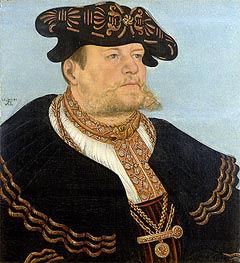Princes' Altarpiece, c.1507/09 by Lucas Cranach the Elder
Canvas Print - 14187-CLE
Location: Anhalt Art Gallery, Dessau, GermanyOriginal Size: unknown
Giclée Canvas Print | $72.81 USD
Your Selection
Customize Your Print
By using the red up or down arrows, you have the option to proportionally increase or decrease the printed area in inches as per your preference.
*Max printing size: 47.2 x 41.5 in
*Max framing size: Long side up to 28"
"Princes' Altarpiece" will be custom-printed for your order using the latest giclée printing technology. This technique ensures that the Canvas Print captures an exceptional level of detail, showcasing vibrant and vivid colors with remarkable clarity.
Our use of the finest quality, fine-textured canvas lends art reproductions a painting-like appearance. Combined with a satin-gloss coating, it delivers exceptional print outcomes, showcasing vivid colors, intricate details, deep blacks, and impeccable contrasts. The canvas structure is also highly compatible with canvas stretching frames, further enhancing its versatility.
To ensure proper stretching of the artwork on the stretcher-bar, we add additional blank borders around the printed area on all sides.
Our printing process utilizes cutting-edge technology and employs the Giclée printmaking method, ensuring exceptional quality. The colors undergo independent verification, guaranteeing a lifespan of over 100 years.
Please note that there are postal restrictions limiting the size of framed prints to a maximum of 28 inches along the longest side of the painting. If you desire a larger art print, we recommend utilizing the services of your local framing studio.
*It is important to mention that the framing option is unavailable for certain paintings, such as those with oval or round shapes.
If you select a frameless art print of "Princes' Altarpiece" by Lucas Cranach, it will be prepared for shipment within 48 hours. However, if you prefer a framed artwork, the printing and framing process will typically require approximately 7-8 days before it is ready to be shipped.
We provide complimentary delivery for up to two unframed (rolled-up) art prints in a single order. Our standard delivery is free and typically takes 10-14 working days to arrive.
For faster shipping, we also offer express DHL shipping, which usually takes 2-4 working days. The cost of express shipping is determined by the weight and volume of the shipment, as well as the delivery destination.
Once you have added the paintings to your shopping cart, you can use the "Shipping estimates" tool to obtain information about available transport services and their respective prices.
All unframed art prints are delivered rolled up in secure postal tubes, ensuring their protection during transportation. Framed art prints, on the other hand, are shipped in cardboard packaging with additional corner protectors for added safety.
Painting Information
Ah, Cranach. Lucas Cranach the Elder is the sort of artist who never quite fit into the tidy categories we like to impose on Renaissance painters. He always had one foot in medieval stiffness, the other in the sleek lines of modernity. And "Princes' Altarpiece"? Well, it’s exactly that: a study in contradictions, hovering somewhere between the divine and the downright peculiar.
Take the Virgin Mary, for instance. She sits there, cradling the Christ Child - an oddly grown-up looking baby, clutching an apple like a mini Adam about to rewrite the story of original sin. But Cranach isn’t interested in making them look particularly human, no. Mary’s face is polished, serene to the point of being cold. Her expression isn’t so much motherly as it is distant, more like an icon than a real woman with a squirming child on her lap. Then there are the two saints on either side, Saint Barbara and Saint Catherine, one of them rather unnecessarily giving Christ a little helping hand, as if he needed assistance gripping that fruit. It’s as if Cranach couldn’t resist adding a bit of narrative fuss to what is otherwise a rather stiff scene.
But oh, the details. Cranach’s gift lies in the minutiae - look at the textures! The lavishness of the fabrics! Those heavy, velvety reds, the opulent greens. Mary’s robe folds in impossibly perfect waves, and the angels fluttering above are downright cherubic, plump with divine purpose. And yet, Cranach’s angels are always a bit weird, aren’t they? Chubby, mischievous, half-naked little creatures, they seem just as concerned with play as prayer. You can almost imagine them getting bored halfway through their divine duties.
And then, of course, there's the awkward tension in the composition. The figures are all so upright, so posed, they might as well be mannequins. No one’s really looking at each other; they’re all in their own little bubbles. The chalice on the table? It’s just there, like a last-minute addition - as if Cranach realized halfway through, "Ah yes, we need something to remind us this is an altarpiece."
The colors are lush, sumptuous even. But what Cranach does with the light - that’s what sets him apart. The figures glow softly, almost unnaturally, like they're lit from within. It gives the whole piece a kind of ethereal distance, a reminder that we're not supposed to be seeing something from our world. Yet, it’s precisely that tension between the divine and the awkwardly human that makes this painting so deliciously Cranach. He’s not just painting a scene of devotion; he’s playing with it, making us question it. It’s religious art, yes, but with a wink.





















